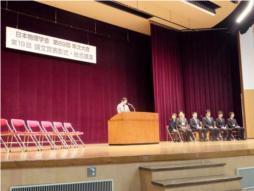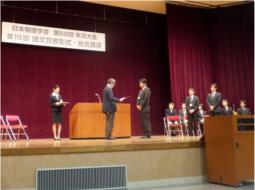The selection committee has chosen the following five papers for the 2014 award out of 19 nominations made by the editors of the two journals and representatives of the 19 divisions of the society.


| Title of Article | Superconductivity at 54 K in F-Free NdFeAsO1-y |
|---|---|
| Journal | J. Phys. Soc. Jpn. 77 (2008) 063707 |
| Authors | Hijiri Kito, Hiroshi Eisaki, and Akira Iyo |
| Citation |
In this paper, a new method was developed for synthesizing the iron-based high Tc superconductors, which was first found in 2008 by Hosono's group. The mother compound of iron-based superconductors often exhibits antiferromagnetism, and superconductivity appears upon doping carriers into the FeAs2 layers. Based on their experiences with cuprate superconductors, the authors succeeded in synthesizing NdFeAsO1-y with Tc=54K using a high pressure technique, where electrons are doped by introducing oxygen deficiencies. This technique simplified the synthesizing process, and hence largely contributed to the extensive studies on iron-based superconductors that followed. For instance, the systematic analysis of the correlation between Tc and the Fe-As-Fe bond angle revealed by Lee et. al. later, was based on the materials synthesized by this method. Also, another interesting finding in this paper is the appearance of high Tc for a large amount of oxygen deficiencies. Quite recently, it has been found by Hosono's group that a large amount of electrons can be doped in iron-based superconductors by substituting oxygen with hydrogen. The relation between the two doping methods is an intriguing question which remains to be answered. In this context, also, the content of the paper is still of great interest even though six years have passed since its publication. |
| Title of Article | Generalized G-Inflation --Inflation with the Most General Second-Order Field Equations-- |
|---|---|
| Journal | Prog. Theor. Phys. (2011) 126 (3): 511-529 |
| Authors | Tsutomu Kobayashi, Masahide Yamaguchi and Jun'ichi Yokoyama |
| Citation | Through various high-precision CMB measurement experiments in recent years, it has become almost certain that the early universe experienced a period of accelerating cosmic expansion called inflation before the hot Big-Bang period, and the central task now is to uncover details of this inflationary stage and pin down its mechanism and the theory behind it. However, we are still far from being able to accomplish this task directly starting from an ultimate unified theory.
Given this background, in the present paper the authors provided a phenomenological and unified framework to attack this task. They carried out a systematic investigation of inflationary universe models based on the most general theory, called the generalized Galileon theory, for a system consisting of Einstein gravity and a single component scalar field, satisfying the requirement that the equation of motion is of the second order. The authors clarified the conditions for inflation to occur stably. Further, they derived general formulas on major statistical quantities for perturbations produced during inflation, which can be used to sort out viable inflationary universe models by observations. Therefore, it became possible to embed predictions of various inflation models studied independently in the past, such as potential-driven inflation models, k-inflation models and inflation models with a non-minimally coupled scalar, into a continuous model space. Utilizing this embedding, they discovered that there exist a rich variety of new models consistent with observations and that these new models make quite different predictions on the amplitude and spectrum of primordial gravitational waves. It is also highly appreciated that they proved the equivalence of the generalized Galileon theory proposed by C. Deffayet and others in 2011 and the most general theory for a single component scalar field derived by G. Horndeski in 1972. The first paper by the Planck experiment published in 2013 strongly indicated that inflation was driven by a single-component slow-roll scalar field. This result suggests that the present paper will play further more important roles in experiments and theoretical studies in the future. |
| Title of Article | The Quiver Matrix Model and 2d-4d Conformal Connection |
|---|---|
| Journal | Prog. Theor. Phys. (2010) 123 (6): 957-987 |
| Authors | Hiroshi Itoyama, Kazunobu Maruyoshi and Takeshi Oota |
| Citation | A connection between conformal field theories in two dimensions and those in four dimensions has been pointed out by Alday, Gaiotto, and Tachikawa. This connection is called AGT correspondence. It has been recognized that the correspondence is valid for wide range of theories, but the physical reason why such a relation holds is not yet known. This article tried to explain the AGT correspondence using a matrix model already at the infancy of this topic, and attracted much worldwide attention. Many researchers are interested in this line of thought, and are still pursuing research quite actively.
As a concrete method, one starts to express conformal field theories in two dimensions in terms of N=2 supersymmetric matrix models of the quiver type. By integrating the matrix model, the authors obtained the loop equations. On the other hand, N=2 supersymmetric gauge thoeries in four dimensions can be expressed in terms of instanton sums, leading to the Seiberg-Witten curve. The authors demonstrated the correspondence between the loop equations and the Seiberg-Witten curve. This article is highly evaluated by its inspiring role in this line of research. |
| Title of Article | Spin-Orbit Interaction in Single Wall Carbon Nanotubes: Symmetry Adapted Tight-Binding Calculation and Effective Model Analysis |
|---|---|
| Journal | J. Phys. Soc. Jpn. 78 (2009) 074707 |
| Authors | Wataru Izumida, Kentaro Sato, and Riichiro Saito |
| Citation |
Generally, the effect of spin-orbit interaction is small in materials consisting of carbon. Hence, it has been scarcely considered except in the case of a diamond, wide band-gap semiconductor. In this paper, the authors report on the effect of spin-orbit interaction on the radius- and chirality-dependent electronic structure of carbon nanotubes using a high-quantitative-accuracy tight-binding model with an overlap matrix. It was theoretically predicted and later confirmed experimentally that carbon nanotubes can possess either metallic or semiconducting electronic transport properties. On the other hand, the production of single-radius and single-chirality nanotube samples has been difficult due to their wide variety of geometries. Recently, however, uniform-geometry samples were finally produced experimentally and it is now expected that high-accuracy electronic-structure studies of each carbon nanotube will be performed soon. It was predicted from quantitative electronic-structure theory that most of the so-called metallic carbon nanotubes are semiconductors having a small but finite energy gap due to the finite curvature effect, and that armchair nanotubes are the only metallic nanotubes. Interestingly, the inclusion of spin-orbit interaction can give rise to a very small but finite energy gap even in these armchair nanotubes. Therefore, the quantitative understanding of spin-orbit interaction including the effect on a valence-band top and a conduction-band bottom of the semiconducting carbon nanotubes is now scientifically and technologically of high importance. In this work the authors have evaluated and discussed the effects of spin-orbit interaction in many carbon nanotubes with optimized geometries using a tight-binding model with chiral-symmetry operations. This paper thus provides a comprehensive report on an important subject. |
| Title of Article | Scaling Properties of Granular Rheology near the Jamming Transition |
|---|---|
| Journal | J. Phys. Soc. Jpn. 77 (2008) 123002 |
| Authors | Takahiro Hatano |
| Citation |
The jamming transition may be regarded as a nonequilibrium phase transition of athermal particulate systems, such as granular matter or emulsions. The phenomenon is characterized by the acquisition of nonzero elastic moduli (e.g., shear modulus and bulk modulus) so that a system does not flow under nonzero stresses. It has been reported in many recent experiments and simulations that the jamming transition shares many aspects with critical phenomena, particularly growing correlation length and time in terms of dynamical heterogeneity. This is similar to what has been observed in various glass formers and thus jamming transition has been attracting many researchers, who have belonged to somewhat different fields. This author has made some important contributions on this topic. Among them, this paper may hold a prominent position. Prior to this paper, P. Olsson and S. Teitel [Phys. Rev. Lett. 99 (2007) 178001] show for the viscosity and a correlation length in the proximity of the jamming critical point a scaling law that is characteristic to critical phenomena. Their result is based on a numerical simulation on a 2D particulate system with the linear repulsive force and the mean-field energy dissipation. In the same year, the present author also found a similar critical behavior independently [J. Phys. Soc. Jpn. 76 (2007) 023001], together with M. Otsuki and S. Sasa. Along this line of thought, the author then proceeded to a more systematic study, which eventually evolved to the awarded paper. In this paper, the author tries to test the universality of jamming criticality by conducting an extensive simulation on 3D systems, where the inter-particle force may be either linear or Hertzian. In a wide range of densities from below to above the jamming critical point, he finds that the shear stress, the pressure, and the temperature satisfy critical scaling laws. Below the critical point, these quantities exhibit Bagnold's scaling, in which the shear stress vanishes in the zero shear-rate limit. Above the critical point, the system possesses non-vanishing shear stress at this limit so that it behaves as a solid. At the critical density, the above three quantities show power-law dependences on the shear rate with nontrivial exponents. All these behaviors are well described by critical scaling laws with six exponents. Furthermore, the author found that these six exponents depend on particle-interactions and thus they are not universal as opposed to conventional critical exponents. This finding illustrates an interesting aspect of nonequilibrium phase transitions in comparison with conventional critical phenomena. He also conjectured that the exponents are independent of the dimensionality of the system, which was evidenced by Otsuki and Hayakawa [Phys. Rev. E 80 (2009), 011308]. This paper has expanded a new horizon on the studies on the jamming criticality. |
